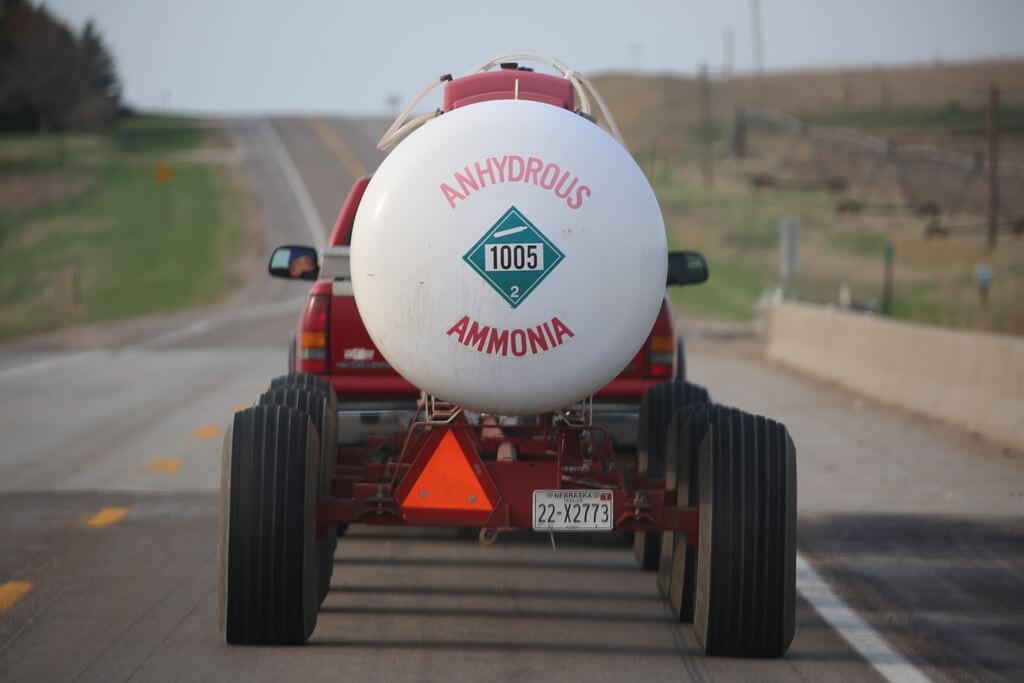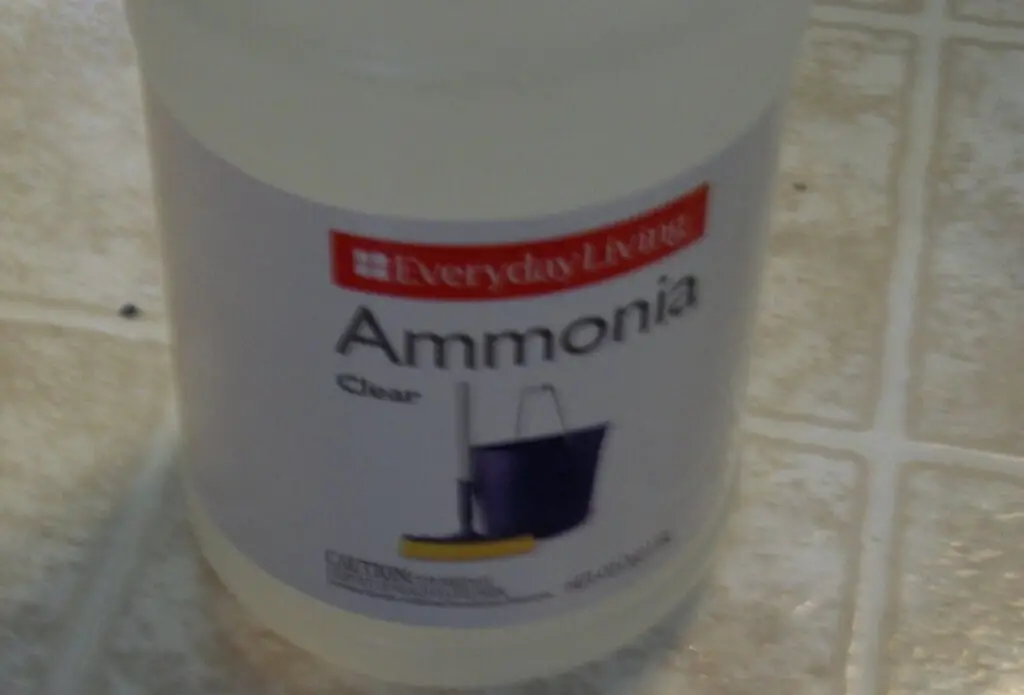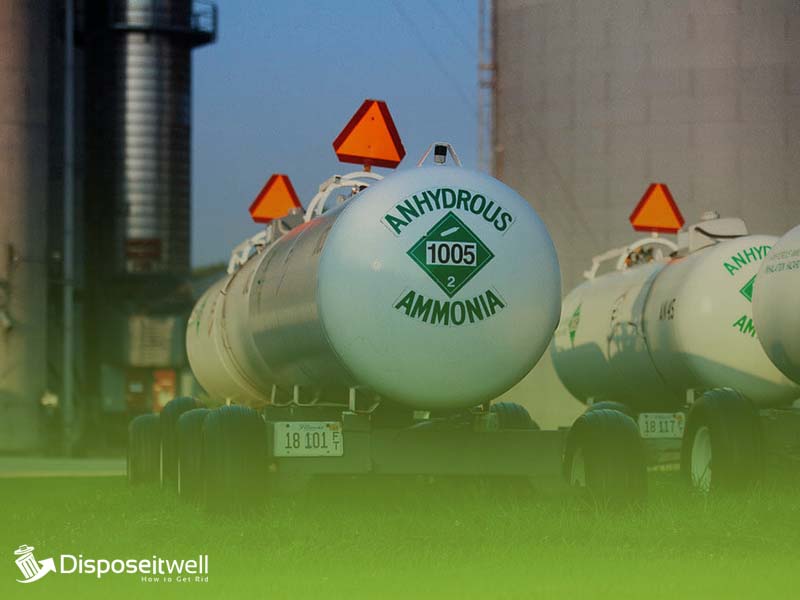Ammonia, a colorless gas with a pungent odor, has become a ubiquitous substance in both industrial and household settings. Used as a cleaning agent, fertilizer, and refrigerant, ammonia is an essential component of modern life.
Improper disposal of ammonia can result in dangerous consequences, such as inhaling ammonia gas can cause irritation of the eyes, nose, and throat, and exposure to high concentrations can lead to respiratory failure and even death.
The potential harm of mishandling ammonia is why it is crucial to know how to dispose of it correctly. In this blog post, we’ll take you on a journey through the ins and outs of ammonia disposal.
From the science behind the chemical formula to the precise details of safe handling and the dangers associated with improper disposal, we’ll leave no stone unturned.
By the end of this post, you’ll have a deep understanding of the importance of responsible ammonia disposal and the tools you need to do your part in protecting yourself and the environment. So let’s dive in and explore the fascinating world of ammonia disposal together.
Risks Of Improper Disposal
Improper disposal of ammonia can pose significant risks to both human health and the environment. When not handled appropriately, ammonia can contaminate water sources, harm wildlife, and pose serious health risks to those exposed.
1. Environmental Impacts Of Ammonia Pollution
Improper disposal of ammonia can also have severe environmental impacts. When ammonia is released into the environment, it can contribute to pollution and harm wildlife. Ammonia can contaminate water sources, leading to the death of fish and other aquatic life.
It can also cause eutrophication, a process in which an excess of nutrients in water bodies leads to the growth of harmful algae and other organisms that can further harm aquatic ecosystems.
In addition, when ammonia enters the soil, it can alter soil pH and nutrient levels, affecting the growth of plants and the health of the ecosystem.
2. Health Risks To Humans And Animals
Exposure to ammonia gas can pose significant health risks to both humans and animals. When inhaled, ammonia can cause irritation and damage to the respiratory system. The following are some of the health risks associated with ammonia exposure.
For Humans
1. Respiratory problems
Ammonia can cause irritation of the eyes, nose, and throat, and can also lead to coughing, wheezing, and shortness of breath. Prolonged exposure to high levels of ammonia gas can lead to more severe respiratory problems, including bronchitis and pneumonia.
2. Skin and eye irritation
As a corrosive gas, ammonia can cause irritation and burns to the skin and eyes. When handling ammonia, it’s important to wear protective gloves and eyewear to prevent contact with the skin or eyes.
3. Asthma
People with asthma may experience asthma attacks when exposed to ammonia gas. This is because ammonia can cause inflammation and irritation of the airways, leading to breathing difficulties.
4. Headaches and dizziness
Headaches, nausea, and dizziness can be caused by exposure to ammonia gas. In high concentrations, it can also lead to loss of consciousness and even death.
For Animals
Animals are also at risk of exposure to ammonia, particularly those that are housed in environments where ammonia is commonly used, such as livestock farms, poultry houses, and pet stores. Exposure to ammonia can have a range of negative health effects on animals, including
1. Respiratory problems
Just like humans, animals can experience respiratory problems due to exposure to ammonia gas. This is especially true for animals that are kept in enclosed spaces where ammonia levels can become concentrated. Prolonged exposure to high levels of ammonia can lead to chronic respiratory issues and even death.
2. Reduced productivity
Livestock such as cows, pigs, and chickens may experience reduced productivity and growth due to exposure to ammonia. This can lead to economic losses for farmers and breeders.
3. Eye and skin irritation
Animals, particularly those with sensitive skin and eyes, can experience irritation and burns due to contact with ammonia. This can cause pain and discomfort, and in severe cases, may require medical treatment.
4. Stress and behavioral problems
Exposure to ammonia can cause stress and anxiety in animals, which can lead to behavioral problems such as aggression and reduced social interactions.
Legal requirements for ammonia disposal

According to the National Library of Medicine, proper disposal of ammonia involves several legal requirements. Solutions of ammonia can be diluted with water or neutralized with HCl before being disposed of in the sewer system. Moreover, National library of medicine states that direct disposal of liquefied ammonia or large amounts of gaseous or aqueous ammonia into water is not recommended due to the heat generated, which could increase the risk of exposure to personnel.
The Minnesota Department of Agriculture (MDA) has certain requirements for the proper disposal of ammonia. “When adding ammonia, it should be done slowly to prevent a violent reaction. A sufficient amount of water must be available, with no more than 20 gallons of ammonia added per 100 gallons of water, resulting in a 10% ammonia solution with an 8.2% nitrogen concentration by weight.
If the water supply becomes saturated with ammonia, it can no longer absorb any more added ammonia, and adding more will create an exposure hazard. Finally, it is recommended that only someone trained and experienced in handling ammonia should attempt to bleed ammonia into the water.”
How To Dispose Of Ammonia Safely?
Precautionary Measures
Wear Protective Gear
When handling ammonia, always wear protective gear, including gloves, goggles, and a mask to avoid inhalation of fumes. Ammonia can cause skin and eye irritation, and it can be harmful if inhaled.
Avoid Mixing with Other Chemicals
Never mix ammonia with other chemicals as it can create a dangerous reaction. This includes bleach, which can create toxic fumes that can be harmful if inhaled.
Use Label Containers
Always use label containers that contain ammonia to ensure they are not mistaken for other chemicals. This is especially important if you plan on storing the ammonia before disposing of it.
Follow Local Regulations
Be sure to follow local regulations and guidelines when disposing of ammonia. This may include contacting a professional disposal service or taking the waste to a designated hazardous waste facility.
Ventilate the Area
Ensure the area where the ammonia is being disposed of is well-ventilated to avoid inhaling any fumes. Open windows and doors or use a fan to help circulate the air.
Steps To Dispose Of Ammonia
1. Dilute With Water
Since ammonia is water-soluble, it’s simple to dilute it with plenty of water. Remember to always use more water than ammonia, with the recommended ratio being one part ammonia to ten parts water. This way, you can ensure that the ammonia is safely diluted and won’t cause harm to your plumbing or environment.
To dilute ammonia, you have a couple of options. You can slowly pour it down the sink while running water from the faucet, or you can flush it down the toilet. However, it’s crucial to make sure that you never use more ammonia than water, especially if your toilet is connected to a septic system. This is because traces of ammonia can contaminate the groundwater, causing environmental harm.
Remember, it’s not recommended to use these procedures for homes using a septic system. If you’re unsure how to dispose of ammonia safely in your area, make sure to follow local regulations and guidelines.
2. Use Of Absorbents
Absorbents are materials that are used to soak up liquids. They are particularly useful when dealing with small spills of ammonia. Some common absorbents include sand, kitty litter, sawdust, paper towels, and baking soda.
Simply sprinkle the absorbent over the spill and allow it to soak up the liquid. Once the ammonia has been absorbed, use a dustpan and broom to sweep up the absorbent material.
After the ammonia has been absorbed, it is important to dispose of it safely. Do not pour it down the drain or into the trash. Instead, place it in a sealable container and label it as hazardous waste. Check with your local waste management facility to find out how to properly dispose of hazardous waste in your area.
3. Professional disposal services
Professional disposal services provide a range of services to help people to safely and responsibly dispose of ammonia. These services can include chemical waste pickup, hazardous waste disposal, and onsite destruction of ammonia.
Examples of professional disposal services include Clean Harbors, Stericycle, and Veolia. These companies provide a safe and secure way for individuals and businesses to dispose of hazardous materials such as ammonia, ensuring that it is disposed of responsibly and in accordance with local laws and regulations.
Alternatives To Disposal Ammonia

Suggestions for ways to use up or repurpose ammonia
Ammonia is a versatile household cleaning agent that can be used in many ways. If you have leftover ammonia that you don’t want to waste, here are some suggestions for ways to use it up or repurpose it
Clean outdoor surfaces
Outdoor surfaces such as patio furniture, outdoor grills, and even the outside of your house can be cleaned with ammonia. Mix 1 cup of ammonia with 1 gallon of water, and use a scrub brush to clean the surfaces.
Clean floors
Using ammonia to clean hard floors like tile or linoleum is an option. Mix 1/2 cup of ammonia with 1 gallon of warm water, and use a mop to clean the floors.
Remove stains
You can use ammonia to remove stains from clothing, carpets, and upholstery. Mix 1 tablespoon of ammonia with 1 cup of water, and use a clean cloth to remove the stain.
Deodorize trash cans
Trash cans can be deodorized and cleaned with ammonia. Mix 1/4 cup of ammonia with 1 gallon of water, and use a sponge to wipe down the inside of the trash can.
Repel rodents
To repel rodents such as mice and rats, ammonia can be used. Soak a few cotton balls in ammonia and place them in areas where rodents are likely to enter.
Clean jewelry
Ammonia can be used to clean gold and silver jewelry. Mix 1 part ammonia with 6 parts water, and soak the jewelry in the solution for 1-2 minutes. Rinse the jewelry with water and dry with a soft cloth. (Read Full Guide on The Spruce.com)
Tips For Reducing Your Need For Ammonia In The First Place
There are many non-ammonia products that can be used as cleaning agents. Here are some examples
Vinegar
A suitable solution for ammonia when cleaning windows and other surfaces is vinegar.It can also be used as a fabric softener.
Baking soda
Baking soda can be used to clean sinks, tubs, and toilets. It can also be used as a deodorizer.
Lemon juice
For cleaning cutting boards, countertops, and microwaves, use lemon juice. It can also be used to polish copper and brass.
Essential oils natural air fresheners and disinfectants can be made from essential oils. Tea tree oil is an effective cleaner for bathrooms, while lavender oil is great for cleaning up sheets and towels.
FAQs
Can I flush ammonia down the drain?
Yes, you can flush ammonia down the drain, however, it is important to dilute it first with a large amount of water (at least 10 parts water to 1 part ammonia).
Additionally, make sure to flush the ammonia with plenty of cold water and avoid pouring it down a hot drain. It is also important to follow local safety guidelines and regulations when disposing of ammonia.
How do you neutralize liquid ammonia?
To neutralize liquid ammonia, mix it with a diluted acidic solution like vinegar or citric acid. This creates ammonium salts that are less harmful to the environment.
Take safety precautions by wearing protective clothing and working in a well-ventilated area. Once neutralized, dispose of the ammonia according to local guidelines.
How fast does ammonia evaporate?
When exposed to open air and in normal condition ammonia evaporates at a rate of 0.12 grams per second after the first 2 minutes. Half a minute later (2 minutes in total), the evaporation rate decreases to half of the initial rate, which is 0.06 grams per second.
However, it is important to note that the rate of evaporation can be affected by various factors such as temperature, humidity, and airflow.
Final Thoughts!
Proper disposal of ammonia is crucial for the safety of humans and the environment. It is essential to identify the type and quantity of ammonia and follow local regulations and safety protocols.
Taking necessary precautions such as wearing protective clothing, working in a well-ventilated area, and using appropriate chemical solutions or dilution methods can help minimize potential harm. By following established guidelines and regulations, we can ensure safe disposal and protect yourself and your nearones from hazardous materials.

Gemma Alexander has an M.S. in urban horticulture and a backyard filled with native plants. After working in a genetics laboratory and at a landfill, she now writes about the environment and recycling topics.

